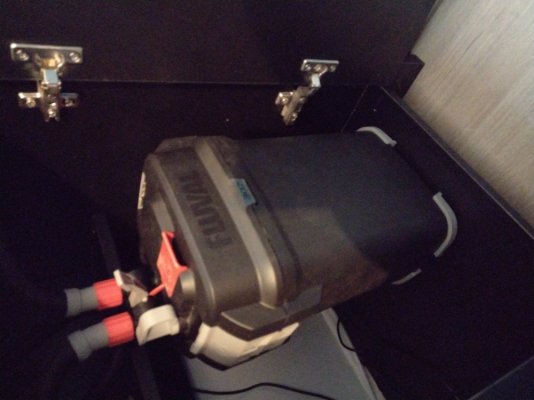That's understandable but it's breaking my heart. So attached to all my little residents already and seeing them go is making me feel bad about fish keeping now.
I have an external filter in the cabinet beneath the tank.
Fluval 307.
I've added a picture. Again it's not great quality. Phone camera is rubbish. Thanks
Power filters should be cleaned at least once a month, unless they are new. In which case they shouldn't be cleaned for the first 6-8 weeks. This it the time the beneficial filter bacteria are developing and attaching themselves to the filter media. The filter media is anything in the filter that traps gunk, holds good bacteria, or removes chemicals and heavy metals from the water. This includes filter pads, sponges, ceramic or plastic beads/ balls, carbon, zeolite, phosphate or nitrate removing substances. Basically, if it's in a filter and used by the filter for trapping gunk, holding bacteria, or removing things from water, it is filter media.
To clean a power filter:
1) Turn the filter off and unplug it from the power socket. Take the filter outside or put it in the bathroom or kitchen sink before opening it. This will stop water splashing on the floor.
2) Take the filter media out and wash the filter materials/ media in a bucket of tank water and re-use the media when it has been cleaned. The cleaned media can sit in the aquarium or another bucket of tank water while you clean the rest of the filter. The bucket of dirty water can be poured on the lawn/ garden outside.
3) Wash the filter case and impellor assembly under tap water. The impellor assembly consists of a magnet with 3 or 4 plastic blades on one end, and a steel or ceramic shaft that goes through the middle of the magnet. There is normally a rubber grommet on either end of the shaft and sometimes a plastic washer between the grommet and impellor. Make sure you don't lose these bits because the pump won't work properly without them.
4) When the impellor, shaft and inside of the motor (where the impellor lives) are clean, put everything back together and put the filter back on the tank.
*NB* The motors for power filters are normally sealed in a plastic resin and are unlikely to get water on the electrical components and blow up or burn out. So a bit of water splashed on the motor should not cause any problems.
If you have carbon (small black granulated substance) or Zeolite (small white granules) in the filter, these should be removed and replaced with some sponge.
Carbon adsorbs chemicals from water and is not normally needed in the average aquarium.
Zeolite adsorbs ammonia and interferes with the development of the good filter bacteria.
If you have filter pads/ cartridges in the filter, these can be replaced with sponge. But add some sponge to the filter and leave it with the filter pads for a couple of months, then throw the pads away. You can buy sponges for different brands of filter and use a pair of scissors to cut the sponge to fit your filter. Sponges last for years and get squeezed out in a bucket of tank water and re-used. I used AquaClear sponges but there are plenty of other brands. Just get one that is slightly bigger than the filter pad and cut it to fit.
--------------------
PRIMING FILTERS
You have an external canister filter that needs to be filled with water before it is turned on. The filter is set up with the clean filter media and sealed up. You connect the filter to the aquarium by 2 hoses. One hose is an intake and the other is a return. You have the intake hose in the aquarium, and the outlet/ return hose in an empty bucket. Suck on the return hose so water drains from the aquarium, into the filter. Let the filter fill with water and start flowing out of the return hose. Then put your thumb over the outlet of the return hose and put the hose in the aquarium. When it is fitted in the tank, turn the filter on.

